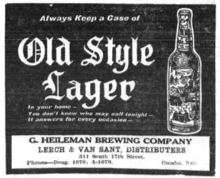G. Heileman Brewing Company
The G. Heileman Brewing Company of La Crosse, Wisconsin, United States, was a brewery firm that operated from 1858 to 1996. It was ultimately acquired by Stroh's, and its independent existence ceased. From 1872 until its acquisition, the brewery bore the family name of its co-founder, brewer Gottlieb Heileman.
History

Key brewery CEOs in the life of Heileman's were Heileman's son-in-law and successor, Emil T. Mueller, and Russell Cleary.[1] Mueller introduced what was to become Heileman's leading "premium" beer label, Heileman's Old Style Beer, in 1902. Building on a strategy begun by his predecessors, Cleary accelerated an acquisition and consolidation effort in the 1970s and early 1980s that gathered a significant percentage of old-line brewery names and intellectual properties into the Heileman family. Heileman acquired 13 breweries between 1959 and 1980. But in 1987 he lost control of the firm to Alan Bond of Australia in a leveraged buyout.
Bond, who already controlled the Tooheys name and beer interests in Australia, hoped to build a worldwide brewing combine. Lacking cash, he financed the acquisition of G. Heileman with junk bonds. The collapse of Bond's financial empire led indirectly to the end of Heileman's existence as an independent brewer. The private equity firm Hicks, Muse bought G. Heileman in 1994, and sold the company to competitor Stroh Brewery Company two years later. G. Heileman's brewery names and intellectual properties became part of the Pabst Brewing Company, the current owner, when Stroh was split between Pabst and the Miller Brewing Company. Pabst oversees the brewing of several well-known Heileman brands, including Old Style and Special Export, under the G. Heileman name.
Historic U.S. brewing names that were consolidated into G. Heileman during its final years include Black Label, Blatz, Blitz-Weinhard, Drewry's, Falls City, Grain Belt, Gluek Brewing, National Bohemian, Olympia, Rainier, Christian Schmidt, Jacob Schmidt, and Wiedemann. At its height the Heileman's combination was the third largest brewer in the United States, behind Anheuser-Busch and Miller.
As a direct result of the Alan Bond collapse, the G. Heileman Brewing Company declared bankruptcy in January 1991. The troubled firm sought salvation with an aggressive push into the malt liquor market. In a controversial move, company leadership developed a new brand of malt liquor to be named Power Master. "Power Master" brand of malt liquor was brewed with an alcohol by volume of 7.4%, significantly higher than existing malt liquor brands.
Protestors cited Heileman's distribution and advertising strategies as evidence that the company was targeting the high-alcohol beverage toward urban African-Americans, especially in Chicago, one of Heileman's core markets. Fr. Michael Pfleger took a leading role in opposing Power Master, helping to organize a threatened boycott of one of Heileman's established malt liquor brands, Colt 45 which, at the time, had an alcohol percentage of 5.6%. The Colt 45 boycott was called off when the Bureau of Alcohol, Tobacco, Firearms, and Explosives succeeded, in July 1991, in persuading Heileman to pull the "Power Master" brand from the market.[2]
Today
As of 2016, the former Heileman's flagship brewery in La Crosse is owned and operated by the City Brewing Company. The brewery chose to use the name that the former Heileman's used as its startup name in 1858-1872. City Brewing brews beer and packages bottled tea, soft drinks, and energy drinks. It does not have the right to use any of the intellectual property, including beer brand names, associated with the G. Heileman Brewing Company.
World's Largest Six Pack
In 1969 designer Roy Wilson and the G. Heileman Brewing Company constructed a set of metal tanks, holding a total of 22,220 barrels of beer, adjacent to their La Crosse brewery. The tanks were used for inventory storage and were painted in the colors of a six-pack of Old Style. For publicity purposes, the brewery called the tanks the World's Largest Six-Pack. The tanks continued in use as of 2016 by City Brewing, although the Old Style logo had been painted over and replaced by vinyl plastic sheaths printed with the colors and packaging style of City's La Crosse Lager.[3]
Notes
- ↑ "History of the Brewing Industry in La Crosse"
- ↑ Eichenwald, Kurt (1991-07-04). "Company News: U.S. Rescinds Approval of A Malt Liquor". New York Times. Retrieved 2009-11-04.
- ↑ Kirby, Doug; Smith, Ken; Wilkins, Mike. "Return of the World's Largest Six Pack." Roadside America, 2008.
Sources
- Brewed with Style: The Story of the House of Heileman, Paul Koeller and David H. Delano, 2004, published by the University of Wisconsin–La Crosse Foundation and City Brewing Company.